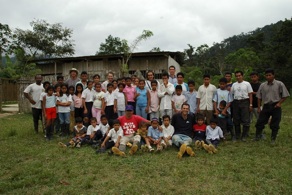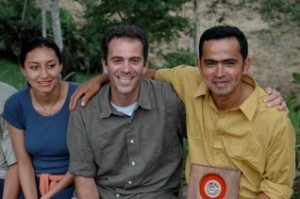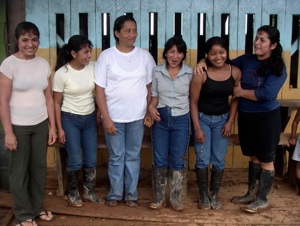South America Engaged Scholarship
 The Chocó rainforest is a unique habitat in South Amercia that receives the highest annual rainfall (up to 16 m per year) on Earth. The Chocó boasts one of the world’s richest lowland biotas, with exceptional richness and endemism in a wide range of taxa including plants, reptiles, amphibians and butterflies. For example, this region houses more endemic species of bird than any habitat type in the Americas, and is home to over 25% of the plant species found in the Neotropics. Yet because of widespread habitat conversion and hunting pressure, Chocó habitat and the exceptional diversity it supports are at risk. In Ecuador, less than 10% of original Chocó forests remain. Our research and conservation work is based in northwest Ecuador, with a focus on 15 communities in the Mache-Chindul Reserve, Esmeraldas Province and the Bilsa Biological Reserve.
The Chocó rainforest is a unique habitat in South Amercia that receives the highest annual rainfall (up to 16 m per year) on Earth. The Chocó boasts one of the world’s richest lowland biotas, with exceptional richness and endemism in a wide range of taxa including plants, reptiles, amphibians and butterflies. For example, this region houses more endemic species of bird than any habitat type in the Americas, and is home to over 25% of the plant species found in the Neotropics. Yet because of widespread habitat conversion and hunting pressure, Chocó habitat and the exceptional diversity it supports are at risk. In Ecuador, less than 10% of original Chocó forests remain. Our research and conservation work is based in northwest Ecuador, with a focus on 15 communities in the Mache-Chindul Reserve, Esmeraldas Province and the Bilsa Biological Reserve.
Training
 A cornerstone of our conservation work is training and employment of local residents as environmental ambassadors. These men and women are highly trained field biologists who formulate hypotheses, design studies, and gather data on endangered species and key ecological processes in the forests surrounding their communities. Through our program, they have become computer literate, coauthored peer-reviewed scientific papers, and made presentations at national and international scientific meetings. At the same time, they serve as advocates for conservation, and have made hundreds of public presentations and hands-on workshops on environmental themes to their own and other communities. As an indication of the success of this program, Mr. Jorge Olivo (pictured left) was awarded the Disney Wildlife Conservation Fund’s ‘Local Conservation Hero Award’, a prestigious international prize in recognition of his outstanding contributions to conservation in the Chocó.
A cornerstone of our conservation work is training and employment of local residents as environmental ambassadors. These men and women are highly trained field biologists who formulate hypotheses, design studies, and gather data on endangered species and key ecological processes in the forests surrounding their communities. Through our program, they have become computer literate, coauthored peer-reviewed scientific papers, and made presentations at national and international scientific meetings. At the same time, they serve as advocates for conservation, and have made hundreds of public presentations and hands-on workshops on environmental themes to their own and other communities. As an indication of the success of this program, Mr. Jorge Olivo (pictured left) was awarded the Disney Wildlife Conservation Fund’s ‘Local Conservation Hero Award’, a prestigious international prize in recognition of his outstanding contributions to conservation in the Chocó.
Education
 We have developed a highly successful model for education in which teachers from local communities meet for one weekend each month to receive training and aids for environmental themes. Since 2004, this project has reached 15 communities and over 500 children each year with themes including basic conservation and ecology, the flora and fauna of the Chocó, and watershed protection. We also put on regular environmental fairs, technical workshops for adults, and hands-on experiential learning opportunities for adults and children.
We have developed a highly successful model for education in which teachers from local communities meet for one weekend each month to receive training and aids for environmental themes. Since 2004, this project has reached 15 communities and over 500 children each year with themes including basic conservation and ecology, the flora and fauna of the Chocó, and watershed protection. We also put on regular environmental fairs, technical workshops for adults, and hands-on experiential learning opportunities for adults and children.
Most recently, we have formed an Ecuadorian NGO named Fundación Conservación de los Andes Tropicales (FCAT). FCAT’s governing board consists of longtime Ecuadorian team members of this project working closely with the broader community to solicit and incorporate information on perceived needs, and how best to meet them. It is the vehicle by which Ecuadorians continue to expand their ownership of the design, implementation, and management of this project.
To learn more about The Chocó of Ecuador, click here!
Related Publications
2015
Browne, L., M. Gonzalez, and J. Karubian. 2015. Biodiversity in forest fragments of the Mache-Chindul Reserve. Quito, Ecuador. PDF
2014
Karubian, J. and R. Durães. Impacts of mating behavior on plant-animal seed dispersal mutualisms: a case study from a Neotropical lek-breeding bird. In Sexual Selection: Insights from the Neotropics (eds. R. Macedo and G. Machado). Elsivier Press. Pp. 365-390. PDF
2013
Carrasco, L., Berg, K. S., Litz, J., Cook, A. and J. Karubian. 2013. Avifauna of the Mache-Chindul Reserve, northwest Ecuador. Neotropical Ornithology 24: 331-324. PDF | Appendix
2013
Karubian, J. 2013. Award for Excellence in Tropical Biology and Conservation. Biotropica 45(6) 772-773. PDF | Web
2013
Durães, R., Carrasco, L., Smith, T. B., and J. Karubian. 2013. Relative effects of forest degradation versus fragmentation on avian communities in a Neotropical biodiversity hotspot. Biological Conservation 166: 203-211. PDF
2013
Kraul, C. 2013. Ecology in Action. Tulanian Magazine. PDF – News piece on work in Ecuador
2012
Scofield, D.G., P.E. Smouse, J. Karubian and V.L. Sork. 2012. Using alpha, beta, and gamma diversity to characterize seed dispersal by animals: social behavior matters. American Naturalist. PDF
2012
Ottewell, K., E. Grey, F. Castillo, and J. Karubian. 2012. Direct parentage analysis reveals non-leptokurtic pollen dispersal in the insect-pollinated tropical palm Oenocarpus bataua. Heredity. doi: 10.1038/hdy.2012.40 PDF | Commentary | Podcast
2012
Karubian, J., R. Durães, J. Storey, and T.B. Smith. 2012. Mating behavior drives seed dispersal in the long-wattled umbrellabird Cephalopterus penduliger. Biotropica 44: 689-698. PDF *Recipient: 2013 Award for Excellence in Tropical Biology & Conservation
2011
Karubian, J., L. Carrasco, P. Mena, J. Olivo, D. Cabrera, F. Castillo, R. Durães, and N. El Ksabi. 2011. Nesting biology, home range, and habitat use of the brown wood-rail (Aramides wolfi) in northwest Ecuador. Wilson Journal of Ornithology 123: 137-141. PDF
2011
Karubian, J. 2011. The Long-wattled Umbrellabid: the feathered gardeners of the Choco. Terra Incognita 72: 8-18. (July 2011) PDF
2010
Karubian, J., V.L. Sork, T. Roorda, R. Durães, and T.B. Smith. 2010. Destination-based dispersal by the long-wattled umbrellabird Cephalopterus penduliger homogenizes genetic structure of a tropical palm. Molecular Ecology 19: 1745-1753. PDF | Cover Page
2010
Karubian, J. 2010. Pompadours in the palms. Natural History Magazine. 119: 28-32. (February 2010) PDF
2009
Karubian, J. 2009. The secret life of the Long-wattled Umbrellabird. El Commercio Newspaper, Ecuador (May 10, 2009) PDF
2008
Karubian, J. and L. Carrasco. 2008. Home range and habitat preferences of the Banded Ground-cuckoo Neomorphus radiolosus. Wilson Journal of Ornithology 120:205-209. PDF
2008
Carrasco, L., A. Cook, and J. Karubian. 2008. Range extensions for eight species of bird in the Mache-Chindul mountains, Ecuador. Cotinga 29:72-76. PDF
2007
Karubian, J., L. Carrasco, D. Cabrera, A. Cook, and J. Olivo. 2007. Nesting biology of the banded-ground cuckoo. Wilson Journal of Ornithology 119(2):222-228. PDF
2003
Karubian, J., G. Casteneda, J.F. Freile, T. Santander, and T.B. Smith. 2003. Breeding biology and nesting behavior of the long-wattled umbrellabird Cephalopterus penduliger in northwestern Ecuador. Bird Conservation International 13:351-360. PDF
